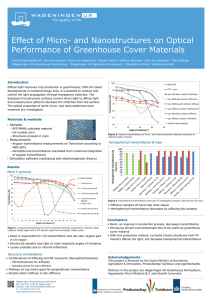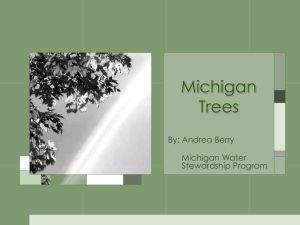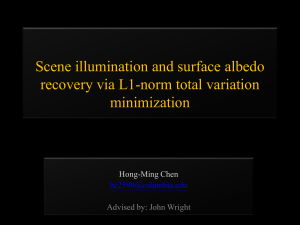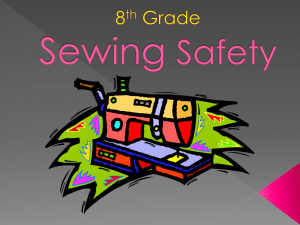15needles
advertisement
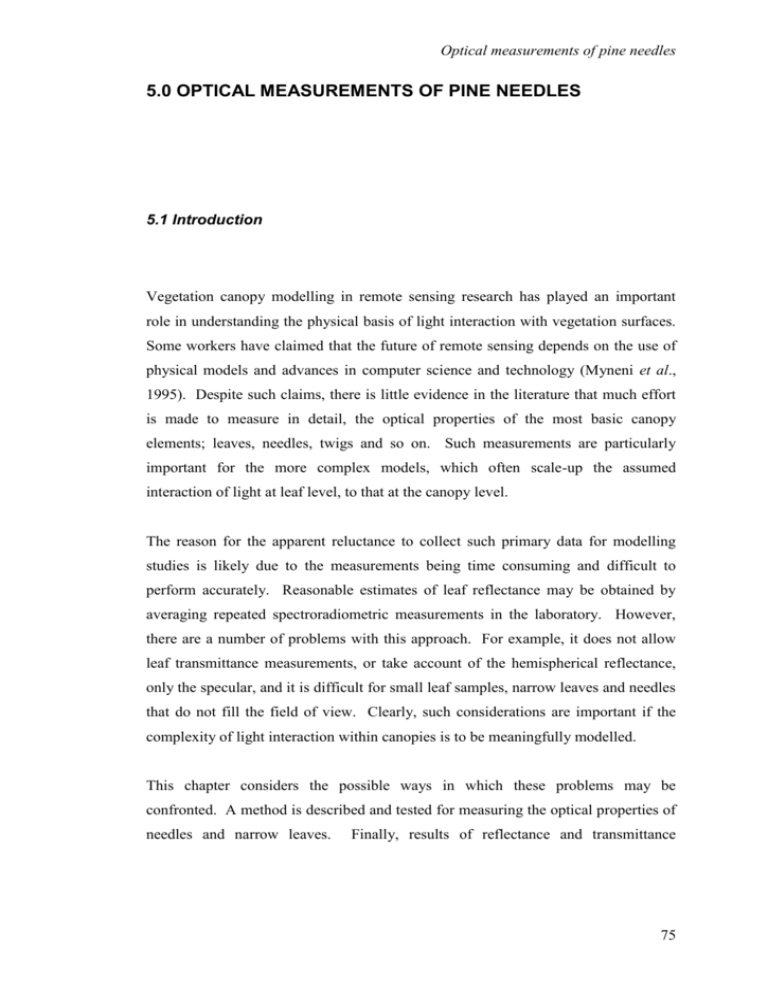
Optical measurements of pine needles 5.0 OPTICAL MEASUREMENTS OF PINE NEEDLES 5.1 Introduction Vegetation canopy modelling in remote sensing research has played an important role in understanding the physical basis of light interaction with vegetation surfaces. Some workers have claimed that the future of remote sensing depends on the use of physical models and advances in computer science and technology (Myneni et al., 1995). Despite such claims, there is little evidence in the literature that much effort is made to measure in detail, the optical properties of the most basic canopy elements; leaves, needles, twigs and so on. Such measurements are particularly important for the more complex models, which often scale-up the assumed interaction of light at leaf level, to that at the canopy level. The reason for the apparent reluctance to collect such primary data for modelling studies is likely due to the measurements being time consuming and difficult to perform accurately. Reasonable estimates of leaf reflectance may be obtained by averaging repeated spectroradiometric measurements in the laboratory. However, there are a number of problems with this approach. For example, it does not allow leaf transmittance measurements, or take account of the hemispherical reflectance, only the specular, and it is difficult for small leaf samples, narrow leaves and needles that do not fill the field of view. Clearly, such considerations are important if the complexity of light interaction within canopies is to be meaningfully modelled. This chapter considers the possible ways in which these problems may be confronted. A method is described and tested for measuring the optical properties of needles and narrow leaves. Finally, results of reflectance and transmittance 75 Optical measurements of pine needles measurements of Scots pine needles are presented and their validity as primary variables for radiative transfer models is discussed. 76 Optical measurements of pine needles 5.2 Previous work Investigations into the optical properties of leaves have been carried out for over one hundred years and the interaction of plants with radiant energy has been of interest to 'the botanist, forester, geographer, biophysicist, biochemist, ecologist, hydrologist, agronomist, photogrammist and others' (Gates et al., 1965). The primary interest has been the understanding of the changes in optical properties relating to changes in leaf physiology. In remote sensing terms, this has promised the opportunity to predict and measure leaf physiological states. However, if laboratory measurements are to assist in the interpretation of data from sensors more remote from the vegetation canopy, then both reflectance and transmittance should be measured on the same sample under the same conditions. This is because the remote sensor will measure the result of light interactions taking place not at the single leaf level, but at the canopy level. Despite the importance of transmittance within the canopy, there has always been a limited amount of published transmittance data for single leaves (Myers and Allen, 1968). One notable exception is the extensive work of Gausman, which has illustrated the role of leaf structure on the measured optical properties of crop leaves (e.g. Gausman et al., 1970; 1984; Gausman, 1977; 1983). For needles, there has been a limited amount, even, of published reflectance data, and transmittance data for needles have been essentially non-existent in the literature (Williams, 1991). Another omission, particularly in the earlier measurements prior to 1930, was the contribution of diffuse light to the measurements. Glossy leaves may tend to follow Fresnel's law for specular reflection, whilst more diffuse reflectance from matt leaves approximate Lambert's cosine law (Myers and Allen, 1968). For most leaves though, light interaction with their surfaces consists of a diffuse and a specular element, so that both must be measured. During the 1930s the Hardy instrument made by General Electric, was among the first to be used with an integrating sphere to measure the diffuse radiation from a sample (Myers and Allen, 1968) and is described by Kortüm (1969, p, 228). An integrating sphere allows the collection of 77 Optical measurements of pine needles all diffuse light reflected from a leaf (or any sample) surface since the inside of the sphere is coated with a perfect reflecting diffuser. In other words, the inside of the sphere is an 'ideal reflecting surface that neither absorbs nor transmits light, but reflects diffusely, with the radiance of the reflecting surface being the same for all reflecting angles, regardless of the angular distribution of the incident light' (Labsphere Inc., date unknown). A generalized theory for measurements made using an integrating sphere is given in Goebel (1967) and the various types and operating theory are detailed by Kortüm (1969 pp. 219-229). In summary, these equations allow the calculation of the difference between the intensity of the reflected flux when a gap in the sphere wall is filled with the sample (i.e. when the sphere is not a perfect diffuser) and when the sphere wall is complete. This is referred to as the substitution method (Kortüm, 1969). The gap is usually referred to as the sample port and may be plugged with a known reference standard; usually of the same coating material as the interior of the sphere. The difference between the measured intensity when the reference is in place and when the sample is in place gives the reflectance factor of the sample, whilst absolute reflectance is obtained if the standard is pre-calibrated. The principle is the same as for field spectroscopy when using a calibrated reflectance panel to standardise measurements; however, the sphere allows the total hemispherical reflectance to be measured from the sample. A popular integrating sphere was the Ulbricht sphere, which required the sample to be suspended within it. Rabideau et al. (1946) were among the first to report the very low absorption of near infra-red light in leaves using an Ulbricht sphere. Modern integrating spheres are generally much easier to use and may be an internal accessory for a relatively low-cost laboratory spectrophotometer, or an external accessory for use in the field with a portable spectroradiometer. The integrating sphere in conjunction with a spectroradiometer has been used extensively to characterise the reflectance and transmittance of a range of leaves. Early research focussed on the interaction of light with the leaf from a functional and physiological perspective. Gates et al. (1965) briefly describe the use of an 78 Optical measurements of pine needles integrating sphere to measure the specular and diffuse radiation from a range of leaves. Two different spectrophotometers were used to obtain measurements from 400 nm to 2000 nm. In the absence of the sensitive measurement devices available today, Gates et al. (1965) made measurements of pine needles by 'forming mosaic samples' in order to obtain a strong enough signal for reflectance measurements. Since transmittance of pine needles is very low, and therefore 'a measurement which is very difficult to obtain', these workers assumed that pine needles do not transmit radiation at all. They note that absorptance in pine needles is greater than for other leaf types, but the estimates of absorptance are likely to be inflated somewhat by the assumption of zero transmittance. Extensive measurements on a variety of crop types were made by Woolley (1971) using a double-beam spectrophotometer with an integrating sphere over a wavelength range of 450 to 2700 nm. The sample leaves were held in place within the sphere on a black sample holder, which allowed measurements with different angles of incidence. Woolley measured surface reflectance over a range of incidence and viewing angles for visible wavelengths and concluded that over half of the visible light reflected by glossy leaves was specular. However, he also concluded that 'reflectance and transmittance characteristics of leaves….can be explained by the fact that a leaf is a good diffuser over the entire wavelength range, containing materials which absorb at specific wavelengths, and bounded by slightly roughened plane surfaces. Most of the diffusion was attributed to the interfaces between air and wet cell walls'. A Perkin Elmer spectrophotometer fitted with and integrating sphere was used to measure the hemispherical reflectance of the upper surface of a range of leaves by Horler et al. (1983). The purpose of this work was to obtain detailed measurements of reflectance to compare chlorophyll concentrations of leaves with the red-edge parameter. Ferns et al. (1984) also concentrated on the red-edge and stressed the importance of high spectral resolution spectra for improving information about such vegetation spectral features. In their laboratory measurements of a pea canopy, hemispherical directional reflectance was measured by dividing the irradiance received by an integrating sphere, by the light received from the target through a slit 79 Optical measurements of pine needles in the base of the sphere. Hemispherical directional reflectance (reflectance factor) 'is the ratio of radiance reflected from a surface in a given direction to that incident upon it' (Duggin, 1980). A more particular definition is given by Williams and Wood (1987) after Nicodemus et al. (1977) as 'the ratio of the radiant flux actually reflected by a sample surface to that which would be reflected into the same reflected-beam geometry by an ideal (lossless) perfectly diffuse (Lambertian) standard surface irradiated in exactly the same way as the sample'. The need to create conditions where the sample illumination characteristics are the same as those for the reference, even for whole plants, or tree branches, has led to the development of measurement systems that integrate each element. For example, Williams and Wood (1987) describe an apparatus containing the spectrometer or radiometer, sphere, the illumination source, the reference standard and the viewing angle on one support structure. However, this apparatus provided no means of acquiring transmittance measurements. More recently, spectral measurements of both canopies and individual leaves have become more practicable and less cumbersome. Field spectroradiometers such as the Li-Cor 1800 have their own integrating spheres as accessories and a lamp as a light source. More sensitive detection devices mean that smaller spheres can be used and fibre optic cables allow more flexible remote detection for such accessories. These instruments and ones like them, have been widely used for reflectance and transmittance measurements of leaves (e.g. Lorenzen and Jensen, 1991; Lichtenthaler et al., 1996; Gitelson and Merzlyak, 1996; 1997; Knapp and Carter, 1998). Figure 5.1 illustrates how an external integrating sphere such as the Li-Cor 1800-12s can be arranged to measure the reference standard, the reflectance factor and the transmittance of a leaf sample. Whilst systems such as the Li-Cor one work well for measuring the optical properties of leaves, particular problems are encountered in the case of needles or leaves smaller than the size of the port entrance. Most importantly, needles do not completely cover the sample port of the integrating sphere so that it is not possible to get a pure target signal for either reflectance or transmittance. Secondly, needles are 80 Optical measurements of pine needles not flat, or regular in shape, so that merely forming a matt of needles side by side does not present a uniform surface representative of a single needle. The irregular shape of the needles will also mean that some light will pass through small gaps, which is particularly confounding for transmittance measurements, especially in the visible wavelengths where transmittance is low (Daughtry et al., 1989). Illuminator Radiation beam Sample holder Port plug Sample Fibre optic to Spectroradiometer Reference standard Figure 5.1 The Li-Cor 1800-12s external integrating sphere in its three configurations for reference (top), reflectance (middle) and transmittance (bottom) modes. Redrawn from Daughtry et al. (1989) 81 Optical measurements of pine needles These workers also observed an increase in reflectance due to multiple scattering between adjacent surfaces when needles were placed side by side. One option is to treat the shoot instead of the needle as the basic optical element in a pine canopy. However, gaps will still exist between needles on a shoot, and transmittance measurements would still be very difficult and inaccurate. Daughtry et al. (1989) described a technique for measuring the reflectance and transmittance of pine needles that tackled these problems. These workers outlined three cases for the measurement of both reflectance and transmittance of narrow leaves and needles using the Li-Cor 1800 apparatus. Case 1 was simply for a leaf sample that completely covered the sample port of the integrating sphere, and followed the arrangement outlined in Figure 5.1. Case 2 was for needles that were long enough to reach across the sample port and Case 3 for needles that were shorter than the diameter of the sample port. For Case 2, needles were laid side by side at about a needle-width apart. Reflectance and transmittance measurements were acquired in the usual manner. However, the proportion of the beam of light that passes through the needle gaps was calculated by measuring reflectance and transmittance after the needles were painted with an opaque matt black paint. This gap proportion was calculated as the ratio of flux at 680 nm transmitted through the blackened sample to the flux at 680 nm transmitted through the sample port with no sample in place. The 680 nm wavelength was chosen because transmittance through green leaves is close to zero in this part of the spectrum, due to absorption by chlorophyll. Case 3 was an extension of Case 2 for needles of pine species that were shorter than the diameter of the sample port of the integrating sphere (14.5 mm in the case of the Li-Cor 1800-12s). The needles were arranged in the same way, but were supported on transparent tape, with the reflectance and transmittance of the tape being measured first and taken into account when calculating the optical properties of the needle samples. These authors stressed the importance of taking care that the needles are placed into exactly the same position over the sample port before and after painting. This was achieved by using holders for the needle samples made from a square of aluminium 82 Optical measurements of pine needles sheet 0.7 mm thick, with a 22 mm diameter hole. The needles were taped over the hole and the sample holder was aligned by marks on the sample holder and the integrating sphere. The method was tested by measuring whole leaves and comparing the results with measurements of strips of whole leaves arranged in the same way as the needle samples. It was concluded that the method proved repeatable, although transmittance was slightly underestimated (typically 6%), whilst reflectance was slightly overestimated (typically 4%). The method of Daughtry et al. (1989) formed the basis of optical measurement methods for needles in subsequent studies. For example, Williams (1991) used the 'Case 3' method and the Li-Cor apparatus (Figure 5.1) when comparing needle, branch and canopy level optical properties for a range of conifer species. He makes the point that the greatest drawback with the method 'was the time-consuming tedious task of painting the needles black without getting paint on the transparent tape medium'. Reflectance of twig samples was made by removing the needles and placing sections of twig side by side, and positioning in front of the sample port of the Li-Cor external integrating sphere. Since twigs are opaque, transmittance data were not obtained for these samples. In a related study, Rock et al. (1994) measured the needle and branch optical properties of two coniferous species to study the differences between first-year and second-year needles and how branch reflectance properties are related to needle-level changes. Needle reflectance and transmittance measurements were made using the method of Daughtry et al. (1989), and the Li-Cor 1800 apparatus. The effect of different fertilization treatments on the optical properties of Douglas Fir seedlings was investigated by Dungan et al. (1996). For leaf optical properties these workers used the 'Case 2' method, but modified for the double beam Perkin-Elmer Lamda-9 spectrophotometer used. The spectrophotometer was equipped with a 15 cm diameter integrating sphere and measurements were made from 400 - 2500 nm. The difference between a single and double-beam spectrophotometer and their associated spheres is discussed in the following section. Dungan et al. (1996) reported that the abaxial (bottom) needle surface reflectance was greatest in the 83 Optical measurements of pine needles visible, while adaxial (top) surface reflectance was greatest at 800-1400 nm. The lower reflectance at the top surface of the needles was attributed to the increased absorption by chloroplasts preferentially grouped near to this surface. The Daughtry method has been improved on recently as a result of work during the The Boreal Ecosystem-Atmosphere Study (BOREAS). Mesarch et al. (1999) introduced modifications to improve both ease of measurement and accuracy. Firstly, they showed that improvements in estimates of transmittance could be made by reducing the gap fraction (GF) typically used (usually needles placed one needlewidth apart; GF approximately 0.3-0.6). Processed Ektachrome slide film was used as a test material to compare whole film transmittance against film strips with different sized gaps. It was concluded that samples with smaller GFs (0.05-0.15) produced mean transmittance values similar to those of the uncut film, with standard deviations < 1.5%, whilst GFs over 0.3 produced increasingly poor estimates of 'true' film transmittance. However, the authors recommended that a larger GF be used for reflectance measurements, because of a slight over-estimation caused by multiple scattering between adjacent surfaces when needles are placed close together. The second improvement made by Mesarch et al. (1999) related to both the estimation of the GF itself and the time consuming painting procedure. GF was estimated directly by imaging the sample and simply counting the proportion of nonneedle to needle pixels in the image. This was done by placing a mask with a hole the same dimensions as the light beam over the sample of needles and taking a photograph with a solid state camera and frame grabber to capture a digital image. It was concluded that whilst this method did not improve on the accuracy of the painting method, it was much less time consuming and allowed the adaxial and abaxial, surfaces to be measured for the same sample. 84 Optical measurements of pine needles 5.3 Method Development and Testing This section details the method used to obtain detailed optical measurements of Scots pine needles. The approach taken follows the image analysis and gap fraction (GF) technique detailed in Mesarch et al. (1999), and described in the previous section. 5.3.1 Materials The spectrophotometer used in the present study was a medium-cost dual-beam UV/Vis/NIR Perkin-Elmer Lamda-40. A Labsphere RSA-PE-20 50 mm integrating sphere internal accessory was used to obtain hemispherical reflectance factor measurements and transmittance measurements. The sphere has two 11 mm diameter ports directly opposite each other and the accessory is aligned with a series of mirrors so that the rectangular sample beam of the spectrophotometer passes through the centre of each port (Figure 5.2). The spectrophotometer can record scans in the 300 to 1200 nm wavelength range. The inside of the sphere and the reference plug were both made from Spectralon ™. Whilst the Labsphere integrating sphere accessory comes equipped with sample holders for solid targets that cover the sample port (such as whole leaves) and a cell sample holder for liquid samples, there is no means of holding a needle sample in place with positional accuracy. Additionally, the sample beam is not the same shape as the sample port and no information was available on the beam dimensions at the reflectance port and at the transmittance port. Two problems with the equipment available therefore, had to be overcome. 85 Optical measurements of pine needles Slide holder for needle samples 8º Sample holder Sample Beam Reflectance Port Sphere housing Transmittance Port Reference Beam Mirrors Figure 5.2 Schematic of the Labsphere RSA-PE-20 internal integrating sphere accessory for the Perkin-Elmer Lamda 40 spectrophotometer. The 8 sample holder was used to capture the specular component of reflectance within the sphere. Firstly, the GF method is reliant on the ability to estimate the proportion of the sample of adjacent needles irradiated by the spectrophotometer's radiation beam. The method of Mesarch et al. (1999) requires a mask to be placed over the sample of adjacent needles so that this proportion can be measured. It was therefore necessary to use a sample holder that could be placed at the sphere entrance ports in exactly the same location every time. This was achieved by making a holder that could be moved up against the entrance ports and receive a 35 mm slide mount, in much the same way as a slide may be dropped into a manual slide projector. The needles were 86 Optical measurements of pine needles taped to a piece of black card, cut to the same dimensions as a 35 mm slide mount and with a hole in the centre. Black card was used instead of actual slide mounts, because the window area was found to be larger than was necessary on slide mounts. Figure 5.2 illustrates the position of the sample holders; one at the reflectance port and one at the transmittance port. Secondly, and perhaps more fundamentally, the precise dimensions of the sample radiation beam had to be measured at the reflectance and transmittance entrance ports to enable GF to be accurately calculated. Whilst the radiation beam could be seen by setting the wavelength to a visible wavelength and dimming the lights, there was no precise way to measure its exact dimensions. Exposing photographic film to the beam was considered as a means of imaging the beam as it entered and exited the sphere. However, it was considered likely that light would diffuse along the film, leaving an undefined boundary to the image. To avoid this effect, a silver-halide photographic emulsion (Liquid Light™, Rockland Colloid Corp., Piermont, NY) was tested. This emulsion is primarily used for making black-and-white enlargements onto virtually any material and has the advantage of high contrast. Speed and contrast of the emulsion were increased by first sensitising the emulsion with one part in ten of working developer. In a dark room environment, the emulsion was warmed to increase viscosity, before being spread evenly on to white card cut to fit the sample holders, and allowed to dry thoroughly. Once dried, the prepared cards were placed into the sample holder against the reflectance port of the integrating sphere. The card was exposed briefly (< 2 seconds) to the spectrophotometer radiation beam, set to white light. Following exposure, the emulsion was processed in four steps. Firstly, the cards were developed with a standard paper developer at a working strength of one part developer to two parts of water. Secondly, excess developer was removed by quickly rinsing with cool water. A powdered hardening fixer was then used (Kodak Unifix™) before finally washing and drying. The process was repeated for cards placed at the transmittance port. 87 Optical measurements of pine needles Figure 5.3 The Perkin Elmer Lamda 40 sample radiation beam dimensions at the sample reflectane port (S) and the transmittance port (T), imaged using photographic emulsion. The halo effect on the reflectance port image is due to diffuse light from within the integrating sphere. Figure 5.3 illustrates the rectangular images of the radiation beam at the sample reflectance and transmittance ports. The emulsion images were used to make masks to overlay the needle samples before scanning to calculate the GF of each sample. 5.3.2 Method Testing Prior to recording measurements of pine needles the method was tested by using unexposed but processed Ektachrome slide film in the same way as Mesarch et al. (1999). The processed film is an inert material with similar optical properties to leaves (i.e. low reflectance in the visible and relatively high transmittance in the NIR). Figure 5.4 illustrates the transmittance of three samples of whole sections of unexposed, processed and developed film, compared with the same film cut into strips and corrected using the GF method. The film strips were placed close together to give small GFs, as recommended by Mesarch et al. (1999). 88 Optical measurements of pine needles Transmittance (%) 100 90 80 70 60 50 40 30 20 10 0 -10400 Transmittance (%) 100 90 80 70 60 50 40 30 20 10 0 -10400 Transmittance (%) 100 90 80 70 60 50 40 30 20 10 0 -10400 Sample A Whole film Film strips GF 0.15 corrected 500 600 700 800 Wavelength (nm) 900 1000 1100 Sample B Whole film Film strips GF 0.13 corrected 500 600 700 800 Wavelength (nm) 900 1000 1100 Sample C Whole film Film strips GF 0.07 corrected 500 600 700 800 Wavelength (nm) 900 1000 1100 Figure 5.4 The whole film, film strips, and Gap Fraction (GF) corrected transmittance spectra for three samples of inert processed, unexposed Ektachrome film. 89 Optical measurements of pine needles The transmittance corrected for the gaps was calculated by where = transmittance through individual film strips or needles, total = Ttotal / REF - STR, Ttotal = total transmitted radiation of the sample, = reflectance of integrating sphere wall, REF = reference radiation, STR = stray light radiation, GF = gap fraction, while the equation for calculating film strip or needle reflectance per waveband is given as where = reflectance of film strips, or individual needles, total = Rtotal - STR / REF - STR, Rtotal = reflected radiation from the sample. The reflectance of the integrating sphere wall () with the reference in place is assumed to be equal to 1. The values of total reflectance (total) and total transmittance (total) include both the contribution from the gaps and the film strips, or needles. measurements In all calculations, the stray light term (STR) was ignored, since were conducted within the spectrophotometer measuring compartment, which serves as a light trap. 90 Optical measurements of pine needles 8 deg. Hemispherical Reflectance Factor (%) 14 12 Sample A 10 8 6 Whole film 4 Film strips 2 0 400 GF 0.15 corrected 500 600 700 800 Wavelength (nm) 900 1000 1100 14 8 deg. Hemispherical Reflectance Factor (%) 12 Sample B 10 8 6 Whole film 4 Film strips 2 0 400 GF 0.13 corrected 500 600 700 800 Wavelength (nm) 900 1000 1100 8 deg. Hemispherical Reflectance Factor (%) 14 12 Sample C 10 8 6 Whole film 4 Film strips 2 0 400 GF 0.07 corrected 500 600 700 800 Wavelength (nm) 900 1000 1100 Figure 5.5 The whole film, film strips, and Gap Fraction (GF) corrected reflectance spectra for three samples of inert processed, unexposed Ektachrome film. 91

